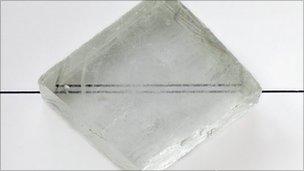Invisibility cloaking benefits from crystal-clear idea
- Published
Researchers have demonstrated an idea for an invisibility cloak using calcite, a common crystalline material.
Cloaking relies on guiding light waves such that waves from a hidden object do not reach the eye.
Calcite accomplishes this by sending the two "polarisations" of light - directions in which the light waves oscillate - in different directions.
The work in Nature Communications, external can hide centimetre-sized objects, limited only by the calcite crystal's size.
The approach offers a simpler, more scalable route to invisibility than prior approaches.
Until now, these have relied on what are known as "metamaterials" - artificially-produced materials that have microscopic variations in their properties that guide incoming light waves around or over a hidden object.

The "birefringence" of the crystal splits light rays into two components, travelling different paths
That bit of trickery works because the light can be manipulated when the material is shaped with features about as big as the light's wavelength - less than a millionth of a metre for light that we can see.
But the principle in calcite is different altogether. It is naturally "birefringent" - meaning it sends light waves of different polarisations along slightly different paths.
The team's invisibility cloak exploits this effect, and relies on a specific geometry comprising two prism-shaped calcite crystals glued together, such that they leave a wedge-shaped gap beneath in which objects can be "cloaked" when illuminated with polarised light.
The team used a prototype to demonstrate the idea, hiding centimetre-scale objects illuminated with polarised green or red laser light.
"By using natural crystals for the first time, rather than artificial metamaterials, we have been able to scale up the size of the cloak and can hide larger objects, thousands of times bigger than the wavelength of the light," said Shuang Zhang, the University of Birmingham physicist who led the research.
"This is a huge step forward as, for the first time, the cloaking area is rendered at a size that is big enough for the observer to 'see' the invisible object with the naked eye."
- Published4 November 2010